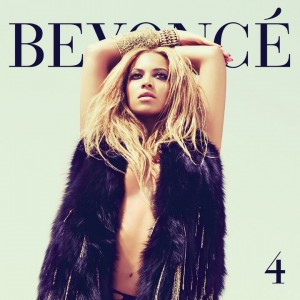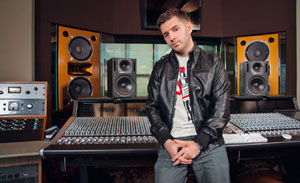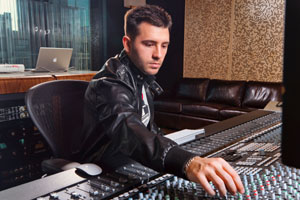Engineer Profile: DJ Swivel on the Making of Beyoncé’s “4”
FINANCIAL DISTRICT, MANHATTAN: If things seem like they’re moving fast for Jordan Young, aka DJ Swivel don’t be sure he feels the same way. Because when you’ve got your shoulder to the wheel like this New York City engineer, you can’t be watching the clock.
He’s just 26, but he’s already earned the distinction of being the full-time engineer for Beyoncé, whose highly anticipated new album 4 drops this week. In addition to doing the trench work throughout, Swivel was trusted enough by Ms. Knowles to mix two songs, “I Care” and “Schoolin’ Life.” But he’d tell you he was just one of the outstanding 4 support team – songwriters, producers and mixers — to help bring Beyonce’s most wide-ranging collection yet to her immense fan base.
Swivel’s role with the reigning R&B queen, who with 75 million+ records sold to date stands as one of the best-selling artists ever, comes after a quick start: a violinst/trumpeter/bassist who’s been DJing since his teens in his native Toronto, Young went to Full Sail and got his post-graduation foot in the door interning with the renowned mixer Duro.
Putting in relentless hours, Swivel’s work ethic got noticed. Seven months after arriving in NYC, he recorded Fabolous’ fourth studio album, From Nothing to Something, and from there his client list kept growing. Jay-Z, Whitney Houston, Britney Spears, Kanye West, a posthumous record for Michael Jackson – Swivel must be on to something.
Relaxing at Engine Room Audio not long after he finished a globe-spanning, 300-work-day year engineering and mixing for the fiercely-working Beyoncé, Swivel took us inside the making of 4 — providing plenty of career inspiration along the way.
You were a serious DJ in your teens, growing up in Canada. Did that enable you to learn to listen to music in a certain way?
Yes, and DJing really helped broaden my musical spectrum as well, because I wasn’t DJing just one genre: I played just about everything you could hear in a club. This wasn’t stuff I was necessarily listening to in my spare time, so it helped evolve my musical tastes. Listening to different genres helps in engineering and production. That’s helpful because if you’re trying to make a song sound like something, you know the tricks in those different genres.
I personally listened to mostly hip hop and R&B, a little bit of dance and rock, but when I was DJing I was exposed to a lot of dance and reggae — having a lot of those influences was helpful as well.
But doing it in my teens, I wasn’t really thinking about the career aspect of it. I just loved doing it. That makes things a lot easier to pick up, when you just enjoy it, and luckily for me it evolved into a career.
How did you and Beyoncé connect initially? What happened in your early work together to indicate that you had chemistry as artist/engineer?
A friend of mine, Omar Grant was an A&R at Epic, and he used to work with Destiny’s Child on the road. Beyoncé needed an engineer for a fill-in day, they called him, he called me, so I came in and did a session. We recorded the beginning stages of “Party,” which is on the album.
That’s the first thing we ever cut, and she said, “You did a great job today. You’re really fast.” Then she left. I felt like a made a good impression.
Then six weeks later I got another call, and they said, “We need you again.” From that point on — May 2010 — we didn’t take any days off. We probably worked 300+ days this year. But it all started from that one chance session. That comes back to my philosophy of always being around, always being available. I’ll drop anything for a session. It doesn’t matter what I’m doing.
Tell us about her goals for 4, sonically.
Beyoncé had finished the biggest tour in the world the year before, and then took a year off. She did all the things she wanted to do. She just got to be a regular person for a year, and so then coming into the project she had all those influences, like Fela Kuti, and ‘90’s throwback R&B. She had a million ideas, and she just wanted to experiment.
We recorded 70+ songs, ranging from ballads to weird ethereal things, to Afrobeat Fela-influenced music, the ‘90’s R&B. The record is very eclectic, but still very much Beyoncé. Her vocal makes everything fit, but musically it’s a very diverse album, and it really takes on the qualities of the music she was listening to, and all the influences she had at that time. So as far as getting on the same page with her, my job was to execute her ideas to the best of my abilities, and I think we accomplished that.
One song with a Fela influence was “End of Time.” With the horns and percussion, it very much has a Fela thing going on. It started with [producer] The-Dream, and then [producer] Switch added elements of electronic music, chopped some vocals in there, created an interesting synth intro sound which is actually a Dream vocal. The bass line is very musical, it’s not just a plain 808 bass: It’s got a vibe to it.
Beyoncé really co-produced this whole album herself as well. For the rest of us, it was executing her ideas. It was: bring a horn section in, a live bass player¸ being able to meld all those live instruments along with the programmed element of it to bring in a new sound. I feel like it was achieved, because there’s not a lot of songs that sound like that. She’s introducing a new sound to pop music with records like that.
How do you capture her vocals?
For this record it was a vintage stereo tube mic but we’re just using one capsule. That’s going into an Avalon 737, but bypassing all EQ and compression, then into an 1176. That’s set at a 4:1 ratio, just kind of kissing the vocals a little bit.
But with her it changes on every song. She’s so dynamic, that it really depends on a song-by-song basis. It’s not like recording a rapper whose vocal is pretty much in the same space. She can go from a very soft, low vocal to a screaming, belting-out kind of sound. For a lot of recording on 4, riding the input is a very important thing. There isn’t one setting.
One of the biggest challenges recording her is capturing the best sound through every part of the vocal. That comes from knowing the song, knowing when she’ll be loud to turn it down, and when she’s soft to turn it up. That really saves a lot of time in the mix, and saves the sonic quality. That way you’re not killing the compressor when she belts out, which results in a thin — not strong — vocal.
“Run the World (Girls)” was the first single off of 4.
What studio or studios did you record at? Were they all in NYC? How were they selected?
The majority of it was done at MSR, but we probably worked at 10 different studios. We did a lot at Jungle City, a little at Germano Studios, a little at KMA, a couple of days in LA at Conway, and then we traveled a little bit.
We did a week in the UK. A few days were spent in Bath, to work at Real World Studios, in the middle of the English countryside. I’ll never forget that experience: We were in his (Peter Gabriel’s) room, he’s got all of his instruments, and it’s like a musical toy shop, jut a real creative space.
In London we did a couple of days in Metropolis, then went to Sydney and built a studio there. Jay-Z and Kanye were there working on Watch the Throne in a mansion. They worked downstairs, we worked upstairs and built a studio on the spot.
How did you go about constructing that room?
We rented a Pro Tools HD rig. There was no booth — I was set just up in the room, recording vocals. It was a very primitive setup, but all she needed was a mic, and the ability to set up a rig. We were in the theater room in their attic. The ceiling was angled, so that helped out acoustically. It worked out. I used a reflection filter, and put her in a corner where we wouldn’t get a lot of ambient noise or unnecessary reflections, and she could do her thing.
A lot of these songs weren’t just, “Go in, record the song and it’s done.” Beyoncé really spent a lot of time producing the songs. She would come in, change lyrics, add harmonies. We may have recorded these songs in five different locations, because we were always coming back to songs and adding, or making revisions.
That sounds like a freeing process.
Yes. There was no “We’re doing this today.” It was a very kind of open project, where whatever she felt like recording at that time was what we’d work on. It was based on how she felt, her mood, and also her listening to the demos that writers would give us. She was always tweaking, always getting it right. Until she felt 100% on it, the song was not done.
Seeing her work ethic is so inspiring, because she’s always trying to perfect everything, and it really shows. That’s why she is who she is. She knows what she wants, how she wants it to sound, and we won’t finish a record until the bell goes off in her head, and she’s like, “Its perfect.”
She’s really the hardest-working person in music. I remember once we worked 36 hours straight, and she sang six full songs. Usually if I go in with an artist, and we get just one song of leads and backgrounds done that’s good. She did six songs in one day.
Doesn’t that tax you as an engineer?
Yeah, but I’m so excited to be there. She’s the best person to work for, because you get to do all the things you normally don’t get to do: Bring in the strings, horns, all of the fun things. It’s not just “Record verse, comp, repeat…” We get to do everything.
When I was coming up, I used to assist for 30-hour sessions. So I’ve done it plenty of times. That doesn’t mean I wasn’t tired, but that’s a part of the job. I just always wanted to be in the studio all of the time.
Now that this year-long, 300+ working-day project is complete, what are you working on next?
I think I’m about to start Fabolous’ new album, I’ve been his engineer since From Nothin’ to Somethin’ in 2006. We have a great chemistry in the studio.
It sounds like you were attracted to the NYC energy, and that it’s really worked for you.
Two days after Full Sail I moved to NYC. I knew nobody up here, I just knew that I wanted to work in urban music, and NYC is the center of that. All the great rappers are from here. I knew I wanted to be working with those sorts of artist, so start with NYC, because that’s where most of them live. My goals are constantly evolving, and to work with the best you have to go where the best work.
That was my reasoning, that’s what made me come up to NYC, and I love the vibe of the city. I like that it’s never sleeping, with something always going on. You have so many people on this small island, and in the boroughs: There’s an energy here that you can’t duplicate anywhere else in the world.
— David Weiss









Thejedimaster
July 1, 2011 at 7:07 am (13 years ago)dave… great article
sunshyne84
September 26, 2011 at 1:30 am (13 years ago)Awesome and inspiring! I love to see people go after their dreams.